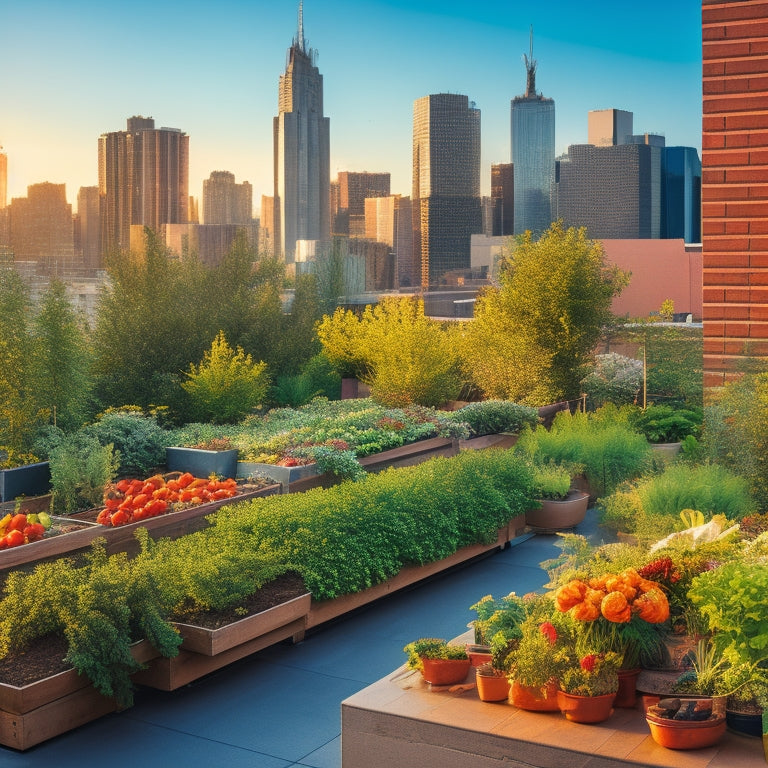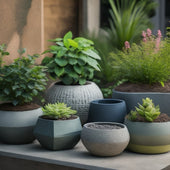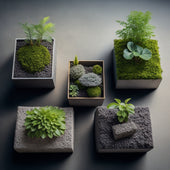
Optimizing Rooftop Space for Thriving Vegetable Orchards
Share
As you plan your rooftop vegetable orchard, start by appraising the space and climate. Measure the dimensions, orientation, and obstructions, and evaluate the local temperature, precipitation, and sunlight patterns. This will help you determine the ideal layout and plant selection. Consider compact and vining vegetables for limited floor and vertical space, and group plants with similar care needs. Employ efficient irrigation and drainage systems, and maximize vertical space with living walls, companion planting, and hydroponic techniques. With careful planning, you'll be on your way to creating a thriving rooftop oasis, and there's even more to explore to take your harvest to the next level.
Key Takeaways
• Assess rooftop space by measuring dimensions, orientation, and obstructions to determine ideal layout and plant selection.
• Choose compact or vining vegetables suitable for rooftop conditions, considering growth habits, space requirements, and climate tolerance.
• Design a functional layout by grouping plants with similar sunlight and care needs, leaving space for air circulation and maintenance.
• Maximize vertical space by using living walls, companion planting, and hydroponic or aeroponic techniques to triple growing capacity.
• Implement efficient irrigation and drainage systems with drip irrigation, timers, and sensors to minimize water waste and prevent clogs.
Assessing Rooftop Space and Climate
Before designing a flourishing vegetable orchard on your rooftop, evaluate the space by measuring its dimensions, orientation, and obstructions, as well as the local climate's temperature, precipitation, and sunlight patterns. This assessment will help you determine the ideal layout and plant selection for your rooftop garden. Consider the amount of sunlight exposure your rooftop receives, taking note of any shading from surrounding buildings or trees.
Weather conditions, such as wind direction and speed, will also impact your garden's layout and plant choice. Next, examine the soil quality on your rooftop, considering factors like pH levels, nutrient content, and drainage. You may need to amend the soil to create a hospitable environment for your vegetables.
Plant compatibility is also essential, as some vegetables thrive in similar conditions while others require distinct environments. By understanding the unique characteristics of your rooftop space and climate, you can create a flourishing vegetable orchard that provides fresh produce for you and your community.
Selecting the Right Vegetables
With a clear understanding of your rooftop's unique conditions, you can now select vegetables that will thrive in this environment, taking into account factors such as growth habits, space requirements, and climate tolerance.
Consider vegetables with compact growth habits, such as leafy greens, herbs, and bush tomatoes, which are ideal for rooftop spaces with limited floor area. For larger spaces, vining vegetables like cucumbers, squash, and peas can make the most of vertical space.
Don't forget to incorporate crop rotation and companion planting principles to guarantee a diverse and resilient ecosystem. For example, planting marigolds alongside tomatoes can deter nematodes, while basil repels pests that target tomatoes.
Be mindful of seasonality and microclimates when selecting vegetables. In warmer microclimates, heat-tolerant vegetables like okra and eggplant will thrive, while cooler microclimates are better suited for broccoli and kale.
Designing a Functional Layout
You'll need to create a functional layout that maximizes space, promotes efficient maintenance, and promotes healthy plant growth by carefully considering the rooftop's dimensions, wind direction, and sunlight patterns. A well-planned layout guarantees that each plant receives the appropriate amount of sunlight and allows for easy access for watering, pruning, and harvesting.
To achieve this, consider the following factors:
| Consideration | Tips |
|---|---|
| Sunlight Patterns | Place plants with similar sunlight requirements together, ensuring that those needing full sun are positioned accordingly. |
| Spacing | Leave adequate space between plants for air circulation, growth, and easy maintenance. |
| Wind Direction | Position plants in a way that shields them from harsh winds, which can cause damage and reduce growth. |
| Plant Varieties | Group plant varieties with similar watering and maintenance needs together to simplify care. |
| Accessibility | Design pathways for easy access to all areas of the rooftop garden, guaranteeing that you can reach each plant without straining or damaging the surrounding plants. |
Maximizing Vertical Space Use
By incorporating vertically-stacked planters, trellises, and wall-mounted gardens, you can triple your rooftop's growing capacity, making the most of every square foot. This allows you to provide a bounty of fresh produce for your community, while also creating a visually stunning oasis in the heart of the city.
To maximize vertical space, consider the following strategies:
-
Create a living wall: Train vining plants like peas, beans, and tomatoes to climb up trellis systems, making the most of your rooftop's vertical real estate.
-
Employ companion planting: Pair plants that benefit from each other's growth, like the 'Three Sisters' method, where corn, beans, and squash thrive together.
-
Experiment with hydroponic and aeroponic techniques: These soilless methods can increase yields while reducing water and land usage, making them ideal for rooftop gardens.
Irrigation and Drainage Systems
As you've tripled your rooftop's growing capacity through vertical space optimization, now it's time to focus on delivering the right amount of water to your thriving vegetable orchard, ensuring each plant receives the perfect balance of hydration and aeration through a well-designed irrigation and drainage system.
To achieve efficient water usage and proper soil drainage, consider the following key components:
| Irrigation System | Drainage System |
|---|---|
| Drip irrigation or soaker hoses to minimize evaporation and runoff | Sloped rooftop surface to prevent water accumulation |
| Timers and sensors to automate watering schedules | Perforated pipes or drainage mats to facilitate water flow |
| Water-efficient nozzles and emitters to reduce waste | Gravel or rock layers to filter excess water |
| Regular maintenance to prevent clogs and leaks | Overflow management systems to prevent waterlogging |
Frequently Asked Questions
How Do I Handle Pests and Diseases in a Rooftop Vegetable Garden?
"You're not just battling a few rogue aphids, you're facing an army of pests and diseases! But fear not, you can wage war with natural remedies and integrated pest management strategies to save your rooftop veggies from certain doom!"
Are Rooftop Gardens Subject to Special Insurance Requirements?
When you establish a rooftop garden, you'll need to secure insurance coverage that addresses liability concerns, ensuring you're protected in case of accidents or property damage, as urban farming regulations vary by region.
Can I Use a Rooftop Garden as a Business or Sell Its Produce?
Like a master chef plating a dish, you can harvest business opportunities from your rooftop garden by crafting marketing strategies and selling techniques that yield profit margins, ultimately serving others with fresh, locally-grown produce.
How Do I Protect My Rooftop Garden From Extreme Weather Conditions?
You'll want to safeguard your rooftop garden withstands harsh weather by implementing a reliable water drainage system and securing structures with wind-resistant materials, like reinforced planters and trellises, to prevent damage and erosion.
Are There Any Rooftop Garden Maintenance Services Available for Hire?
'An ounce of prevention is worth a pound of cure,' so don't hesitate to hire rooftop garden maintenance services for professional care, while also learning DIY solutions and maintenance tips to guarantee your garden thrives.
Related Posts
-

5 Best DIY Planter Ideas to Upcycle Concrete
You're about to breathe new life into discarded concrete blocks by transforming them into functional and visually app...
-

5 Best DIY Planter Ideas to Upcycle Concrete
You're about to breathe new life into discarded concrete blocks by transforming them into functional and visually app...
-

5 Best DIY Planter Ideas to Upcycle Concrete
You're about to breathe new life into discarded concrete blocks by transforming them into functional and visually app...
-

5 Best DIY Planter Ideas to Upcycle Concrete
You're about to breathe new life into discarded concrete blocks by transforming them into functional and visually app...
-

5 Best DIY Planter Ideas to Upcycle Concrete
You're about to breathe new life into discarded concrete blocks by transforming them into functional and visually app...
-

5 Best DIY Planter Ideas to Upcycle Concrete
You're about to breathe new life into discarded concrete blocks by transforming them into functional and visually app...
-

5 Best DIY Planter Ideas to Upcycle Concrete
You're about to breathe new life into discarded concrete blocks by transforming them into functional and visually app...
-

5 Best DIY Planter Ideas to Upcycle Concrete
You're about to breathe new life into discarded concrete blocks by transforming them into functional and visually app...
-

5 Best DIY Planter Ideas to Upcycle Concrete
You're about to breathe new life into discarded concrete blocks by transforming them into functional and visually app...
-

5 Best DIY Planter Ideas to Upcycle Concrete
You're about to breathe new life into discarded concrete blocks by transforming them into functional and visually app...
-

5 Best DIY Planter Ideas to Upcycle Concrete
You're about to breathe new life into discarded concrete blocks by transforming them into functional and visually app...
-

5 Best DIY Planter Ideas to Upcycle Concrete
You're about to breathe new life into discarded concrete blocks by transforming them into functional and visually app...
-

5 Best DIY Planter Ideas to Upcycle Concrete
You're about to breathe new life into discarded concrete blocks by transforming them into functional and visually app...
-

5 Best DIY Planter Ideas to Upcycle Concrete
You're about to breathe new life into discarded concrete blocks by transforming them into functional and visually app...
-

5 Best DIY Planter Ideas to Upcycle Concrete
You're about to breathe new life into discarded concrete blocks by transforming them into functional and visually app...
-

5 Best DIY Planter Ideas to Upcycle Concrete
You're about to breathe new life into discarded concrete blocks by transforming them into functional and visually app...
-

5 Best DIY Planter Ideas to Upcycle Concrete
You're about to breathe new life into discarded concrete blocks by transforming them into functional and visually app...
-

5 Best DIY Planter Ideas to Upcycle Concrete
You're about to breathe new life into discarded concrete blocks by transforming them into functional and visually app...
-

Why Choose the Right Blocks for Your Planters
When creating a thriving planter, you need to choose the right blocks to support the entire ecosystem. Start by evalu...
-

Why Choose the Right Blocks for Your Planters
When creating a thriving planter, you need to choose the right blocks to support the entire ecosystem. Start by evalu...
-

Why Choose the Right Blocks for Your Planters
When creating a thriving planter, you need to choose the right blocks to support the entire ecosystem. Start by evalu...
-

Why Choose the Right Blocks for Your Planters
When creating a thriving planter, you need to choose the right blocks to support the entire ecosystem. Start by evalu...
-

Why Choose the Right Blocks for Your Planters
When creating a thriving planter, you need to choose the right blocks to support the entire ecosystem. Start by evalu...
-

Why Choose the Right Blocks for Your Planters
When creating a thriving planter, you need to choose the right blocks to support the entire ecosystem. Start by evalu...
-

Why Choose the Right Blocks for Your Planters
When creating a thriving planter, you need to choose the right blocks to support the entire ecosystem. Start by evalu...
-

Why Choose the Right Blocks for Your Planters
When creating a thriving planter, you need to choose the right blocks to support the entire ecosystem. Start by evalu...
-

Why Choose the Right Blocks for Your Planters
When creating a thriving planter, you need to choose the right blocks to support the entire ecosystem. Start by evalu...
-

Why Choose the Right Blocks for Your Planters
When creating a thriving planter, you need to choose the right blocks to support the entire ecosystem. Start by evalu...
-

Why Choose the Right Blocks for Your Planters
When creating a thriving planter, you need to choose the right blocks to support the entire ecosystem. Start by evalu...
-

Why Choose the Right Blocks for Your Planters
When creating a thriving planter, you need to choose the right blocks to support the entire ecosystem. Start by evalu...
-

Why Choose the Right Blocks for Your Planters
When creating a thriving planter, you need to choose the right blocks to support the entire ecosystem. Start by evalu...
-

Why Choose the Right Blocks for Your Planters
When creating a thriving planter, you need to choose the right blocks to support the entire ecosystem. Start by evalu...
-

Why Choose the Right Blocks for Your Planters
When creating a thriving planter, you need to choose the right blocks to support the entire ecosystem. Start by evalu...
-

Why Choose the Right Blocks for Your Planters
When creating a thriving planter, you need to choose the right blocks to support the entire ecosystem. Start by evalu...
-

Why Choose the Right Blocks for Your Planters
When creating a thriving planter, you need to choose the right blocks to support the entire ecosystem. Start by evalu...
-

Why Choose the Right Blocks for Your Planters
When creating a thriving planter, you need to choose the right blocks to support the entire ecosystem. Start by evalu...
-

Why Choose the Right Blocks for Your Planters
When creating a thriving planter, you need to choose the right blocks to support the entire ecosystem. Start by evalu...
-

Why Choose the Right Blocks for Your Planters
When creating a thriving planter, you need to choose the right blocks to support the entire ecosystem. Start by evalu...
-

Why Choose the Right Blocks for Your Planters
When creating a thriving planter, you need to choose the right blocks to support the entire ecosystem. Start by evalu...
-

Why Choose the Right Blocks for Your Planters
When creating a thriving planter, you need to choose the right blocks to support the entire ecosystem. Start by evalu...
-

Why Choose the Right Blocks for Your Planters
When creating a thriving planter, you need to choose the right blocks to support the entire ecosystem. Start by evalu...
-

Accurate Measuring for DIY Block Planters Made Easy
As you begin building a DIY block planter, precise measurement is essential for a sturdy structure that can support s...
-

Accurate Measuring for DIY Block Planters Made Easy
As you begin building a DIY block planter, precise measurement is essential for a sturdy structure that can support s...
-

Accurate Measuring for DIY Block Planters Made Easy
As you begin building a DIY block planter, precise measurement is essential for a sturdy structure that can support s...
-

Accurate Measuring for DIY Block Planters Made Easy
As you begin building a DIY block planter, precise measurement is essential for a sturdy structure that can support s...
-

Accurate Measuring for DIY Block Planters Made Easy
As you begin building a DIY block planter, precise measurement is essential for a sturdy structure that can support s...
-

Accurate Measuring for DIY Block Planters Made Easy
As you begin building a DIY block planter, precise measurement is essential for a sturdy structure that can support s...
-

Accurate Measuring for DIY Block Planters Made Easy
As you begin building a DIY block planter, precise measurement is essential for a sturdy structure that can support s...
-

Accurate Measuring for DIY Block Planters Made Easy
As you begin building a DIY block planter, precise measurement is essential for a sturdy structure that can support s...
-

Accurate Measuring for DIY Block Planters Made Easy
As you begin building a DIY block planter, precise measurement is essential for a sturdy structure that can support s...
-

Accurate Measuring for DIY Block Planters Made Easy
As you begin building a DIY block planter, precise measurement is essential for a sturdy structure that can support s...
-

Accurate Measuring for DIY Block Planters Made Easy
As you begin building a DIY block planter, precise measurement is essential for a sturdy structure that can support s...
-

Accurate Measuring for DIY Block Planters Made Easy
As you begin building a DIY block planter, precise measurement is essential for a sturdy structure that can support s...
-

Accurate Measuring for DIY Block Planters Made Easy
As you begin building a DIY block planter, precise measurement is essential for a sturdy structure that can support s...
-

Accurate Measuring for DIY Block Planters Made Easy
As you begin building a DIY block planter, precise measurement is essential for a sturdy structure that can support s...
-

Accurate Measuring for DIY Block Planters Made Easy
As you begin building a DIY block planter, precise measurement is essential for a sturdy structure that can support s...
-

Accurate Measuring for DIY Block Planters Made Easy
As you begin building a DIY block planter, precise measurement is essential for a sturdy structure that can support s...
-

Accurate Measuring for DIY Block Planters Made Easy
As you begin building a DIY block planter, precise measurement is essential for a sturdy structure that can support s...
-

Accurate Measuring for DIY Block Planters Made Easy
As you begin building a DIY block planter, precise measurement is essential for a sturdy structure that can support s...
-

Accurate Measuring for DIY Block Planters Made Easy
As you begin building a DIY block planter, precise measurement is essential for a sturdy structure that can support s...
-

Accurate Measuring for DIY Block Planters Made Easy
As you begin building a DIY block planter, precise measurement is essential for a sturdy structure that can support s...
-

Accurate Measuring for DIY Block Planters Made Easy
As you begin building a DIY block planter, precise measurement is essential for a sturdy structure that can support s...
-

Accurate Measuring for DIY Block Planters Made Easy
As you begin building a DIY block planter, precise measurement is essential for a sturdy structure that can support s...
-

Accurate Measuring for DIY Block Planters Made Easy
As you begin building a DIY block planter, precise measurement is essential for a sturdy structure that can support s...
-

Accurate Measuring for DIY Block Planters Made Easy
As you begin building a DIY block planter, precise measurement is essential for a sturdy structure that can support s...
-

Accurate Measuring for DIY Block Planters Made Easy
As you begin building a DIY block planter, precise measurement is essential for a sturdy structure that can support s...
-

Accurate Measuring for DIY Block Planters Made Easy
As you begin building a DIY block planter, precise measurement is essential for a sturdy structure that can support s...
-

Accurate Measuring for DIY Block Planters Made Easy
As you begin building a DIY block planter, precise measurement is essential for a sturdy structure that can support s...


